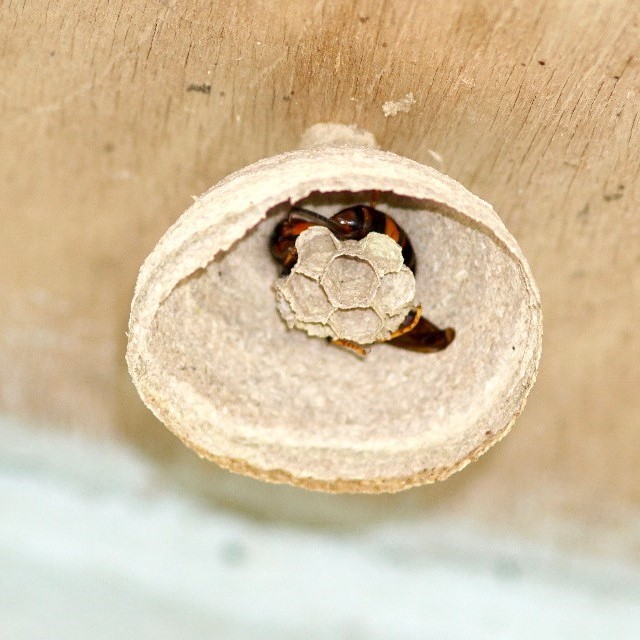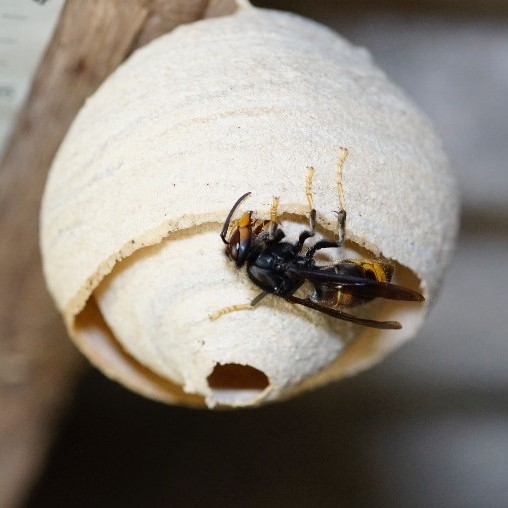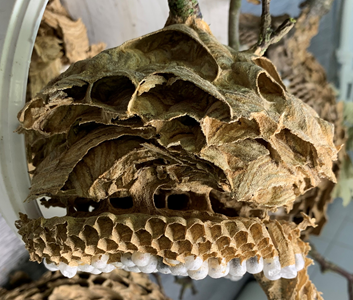When the yellow-legged Asian hornet comes to Devon
Understanding the insect and taking action – a talk by Judith Norman, General Secretary of DBKA.
Report of East Devon Beekeepers meeting held at Kilmington Village Hall on 6th March 2025. 40+ attendees.


Both hornets are predators, but the yellow-legged Asian hornet (YLAH) has a bigger nest, hence more adults to predate our bees. European hornet (EH) nests may contain 500 adults, compared with YLAH’s 5000 adults. This also means there are more new YLAH queens dispersed at the end of the year!
Note the narrow waist or petiole of the worker hornet, which means they can only consume liquid feed.

New YLAH queens hibernate within a few hundred meters of the nest and emerge in spring when the temperature reaches 12°C for a minimum of 3 days. They feed on carbohydrate to replace depleted stores, then migrate, mostly less than 6km.
The queen starts building a primary nest made from chewed up wood fibres and saliva. The primary nest is usually low down in a sheltered place, for example a shed or out house. She then starts laying eggs in the downward-facing hexagonal cells.
In July, the colony decamps to an elevated site, often in a tree, where a much larger secondary nest is built. Sometimes, the original primary nest is expanded without the move to another site. It should also be pointed out that YLAH occasionally build the secondary nest low down in bushes and brambles. These sites are especially dangerous as the hornets become very defensive when disturbed.
 Beginning of proto-nest *
Beginning of proto-nest *
 Proto-nest *
Proto-nest *
 Secondary nest *
Secondary nest *
 Nest structure *
Nest structure *
* Images courtesy The Animal and Plant Health Agency (APHA), Crown Copyright
What are the problems?
- As carnivores, they eat our pollinators. 11kg per nest have been found, including all the major pollinating insect groups.
- This reduces biodiversity and reduces food production from insect pollinated crops.
- They spoil fruit.
- They sting fruit pickers, especially grape pickers and blackberry pickers (single stings).
- They attack people trimming hedges where nests are hidden (multiple stings).
YLAH spread rapidly into new areas, as happened in Belgium between 2020 and 2022. Migration may also be aided by strong winds, as happened in early 2023 when new queens were ‘blown’ over the Channel from France to UK. We are also aware of queens being transported into this country while hibernating in caravans, fruit and other goods.
What can beekeepers do?
- Monitor with Trappit bait, and report to NBU. (Members can obtain Trappit from EDBK AH Team).
- Take opportunities to engage with the public. Encourage them to keep a look out and report.
- Act as verifiers.
- If you are able, help with tracking if needed.
Monitor efficiently
Choose the best place that requires the least effort, and reduces or eliminates unwanted effects of monitoring (bycatch).



Phases of monitoring change with the life cycle, so early in the year the overwintered queens will emerge, feed and migrate somewhere near the old nest. Later, the queen and colony will be in a static nest, which could be anywhere. Early in the year there is a low chance of monitoring being successful but if hornets are identified, then nest access is easy. Later monitoring has a higher chance of success, but by then nests will be inaccessible and almost invisible due to leaf cover. The compromise time is late May to early June, and again in August and September. What about July? Apparently, the colony will be busy water gathering to create the secondary nest, so are less likely to be attracted by bait stations.
The NBU will be trapping around previous sites to catch new queens. Beekeepers can carry out intermittent monitoring with open bait wherever and whenever they have time to watch the bait station.
Verifying
This is an easy, well-defined job and will help to take the load off YLAH Team members. You can decline if you are busy when called. The more verifiers who can be called upon, the easier it will be for everyone.
Getting people engaged
There is plenty of good material available. Judith feels that face to face is easier and more likely to be taken in and understood by the public. It is down to beekeepers locally (for the next few years) to take on the task of ‘spreading the word’.
Tracking
Tracking is the next logical step, especially if the NBU are busy elsewhere when we have a sighting.
AH tracking method, as developed on Jersey.
There are Five steps:
- Place bait station.
- Watch direction of flight to the nest and record it on a map.
- Judge the distance to the nest.
- Place further bait stations.
- Close in on the nest.
What you will need:
Compass
Timer
Notebook
Map print out
Also good to have:
Binoculars
Two-way radio
- Step 1 – Place the bait somewhere the odour of the bait will disperse widely e.g., on a bucket or fence post.
- Step 2 – Observe the direction of flight. Note where you lose sight, and check a matching point on the horizon. Check several flights, and when reasonably consistent, take the central point. Measure this direction with your compass and transfer the direction from the compass onto the map. Satellite view on Google Earth is ideal. Draw the direction line from your location on the map.

- Step 3 – Judge the distance to the nest by measuring the time it takes for a marked hornet to leave and return. Using a timer is easier than using a phone. Every minute of absence means the nest is another 100 metres away. It is often less than 5 minutes in practice.
Hornets fly by visible landmarks so may not fly from the bait directly towards the nest. However, as a marked hornet learns the route, it will start to cut corners and make your results more accurate. Record each return time. These should be quicker as the hornet learns the route. Choose the LOWEST consistent time for your final result.
If hornets return in less than 2 minutes the nest may be closer than you think. This is because they will take time to gain altitude from bait stations near the base of a tree. Unloading time in the nest is usually about half a minute. - Step 4 – Place further bait stations. This may just be a question of moving closer along your compass bearing or you may set up more stations to triangulate, if you can do so without trespassing.

- Step 5 – Close in on the nest. Wait until the return times are less than 2 minutes or when you have three flight paths crossing at one point. Remember that nests are difficult to see in tall trees, so look for skyline ‘traffic’ instead. When nests are in hedges or brambles, stay away. You can hand over to the NBU team at any stage.
Hand over to NBU
Contact the NBU with a clear description of the site, mark the tree/bush etc and preferably give a What 3 Words address. If you suspect a low nest, take precautions to keep the public away.
How to mark without capture
Technically, it is illegal to capture an alien species and then release it after marking. Judith showed a short video of marking a hornet without capture at a bait station using a Posca pen. It can be done, with practice!
She also showed how to attach a streamer for tracking in situations with a dark backdrop such as trees. This is more advanced and requires capture and release.
Further information
New BBKA guide to trapping. Download the PDF file: AH Monitoring Trapping Guidance Leaflet v1 2024.pdf

The second edition of Sarah Bunker’s handbook, ‘The Yellow Legged Asian Hornet’, has been fully revised, expanded and restructured. This comprehensive and practical guide is filled with new information from hornet identification to up-to-date scientific findings on yellow-legged hornet biology, behaviour and ecology. There are also sections on how they are dealt with in the UK and Europe, how to track hornets to find their nests, trapping, and other methods of control.